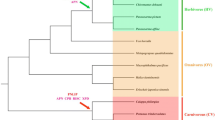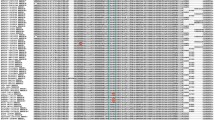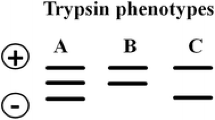Abstract
Fossil evidence suggests that cetaceans evolved from artiodactylans. Thus, there was a major dietary change from herbivorous to carnivorous during their transition from a terrestrial to an aquatic environment. However, the molecular evolutionary mechanisms underlying this dietary switch have not been well investigated. Evidence of positive selection of digestive proteinases and lipases of cetaceans was detected: (1) For the four pancreatic proteinase families (carboxypeptidase, trypsin, chymotrypsin, and elastase) examined in this study, each family included only a single intact gene (e.g., CPA1, PRSS1, CTRC, and CELA3B) that had no ORF-disrupted or premature stop codons, whereas other members of each family had become pseudogenized. Further selective pressure analysis showed that three genes (PRSS1, CTRC, and CELA3B) were subjected to significant positive selection in cetaceans. (2) For digestive proteinases from the stomach, PGA was identified to be under positive selection. (3) Intense positive selection was also detected for the lipase gene PLRP2 in cetaceans. In addition, parallel /convergent amino acid substitutions between cetaceans and carnivores, two groups of mammals that have evolved similar feeding habits, were identified in 10 of the 12 functional genes. Although pseudogenization resulted in each family of pancreatic proteinases only retaining one intact gene copy in cetacean genomes, positive selection might have driven pancreatic proteinases, stomach proteinases, and lipases to adaptively evolve a stronger ability to digest a relatively higher proportion of proteins and lipids from animal foods. This study can provide some novel insights into the molecular mechanism of cetacean dietary changes during their transition from land to sea.



Similar content being viewed by others
References
Axelsson E et al (2013) The genomic signature of dog domestication reveals adaptation to a starch-rich diet. Nature 495:360–364
Breckenridge WC, Marai L, Kuksis A (1969) Triglyceride structure of human milk fat. Can J Biochem 47:761–769
Carey MC, Small DM, Bliss CM (1983) Lipid digestion and absorption. Pediatrics 45:651–677
Carginale V, Trinchella F, Capasso C, Scudiero R, Riggio M, Parisi E (2004) Adaptive evolution and functional divergence of pepsin gene family. Gene 333:81–90
Del Mar EG, Largman C, Brodrick JW, Fassett M, Geokas MC (1980) Substrate specificity of human pancreatic elastase 2. Biochemistry 19:468–472
Dierenfeld ES, Hintz HF, Robertson JB, Van Soest PJ, Oftedal OT (1982) Utilization of bamboo by the giant panda. The Journal of nutrition 112:636–641
Drummond DA, Wilke CO (2008) Mistranslation-induced protein misfolding as a dominant constraint on coding-sequence evolution. Cell 134:341–352
Duke GE (1986) Alimentary Canal: Secretion and Digestion, Special Digestive Functions, and Absorption. Avian Physiol 16:289–302
Fellenius E, Berglindh T, Sachs G, Olbe L, Elander B, Sjostrand SE, Wallmark B (1981) Substituted benzimidazoles inhibit gastric acid secretion by blocking (H+ + K+)ATPase. Nature 290:159–161
Foltmann B (1981) Gastric proteinases: structure, function evolution and mechanism of action. Essays Biochem 17:52–84
Foote AD et al (2015) Convergent evolution of the genomes of marine mammals. Nat Genet 47:272–275
Freeman CP, Jack EL, Smith LM (1965) Intramolecular fatty acid distribution in the milk fat triglycerides of several species. J Dairy Sci 48:853–858
Guindon S, Dufayard JF, Lefort V, Anisimova M, Hordijk W, Gascuel O (2010) New algorithms and methods to estimate maximum-likelihood phylogenies: assessing the performance of PhyML 3.0. Syst Biol 59:307–321
He X, Zhang J (2005) Rapid subfunctionalization accompanied by prolonged and substantial neofunctionalization in duplicate gene evolution. Genetics 169:1157–1164
Jin C, Ciochon RL, Dong W, Hunt RM Jr, Liu J, Jaeger M, Zhu Q (2007) The first skull of the earliest giant panda. Proc Natl Acad Sci USA 104:10932–10937
Jin K et al (2011) Why does the giant panda eat bamboo? A comparative analysis of appetite-reward-related genes among mammals. PLoS ONE 6:e22602
Kageyama T (2002) Pepsinogens, progastricsins, and prochymosins: structure, function, evolution, and development. Cell Mol Life Sci CMLS 59:288–306
Kiraly O et al (2007) Signal peptide variants that impair secretion of pancreatic secretory trypsin inhibitor (SPINK1) cause autosomal dominant hereditary pancreatitis. Hum Mutat 28:469–476
Korbova L, Kohout J (1981) Gastric acid proteinases and their zymogens. Acta Univ Carol Med Monogr 101:1–144
Liu Y et al (2015) Digestion of nucleic acids starts in the stomach. Sci Rep 5:11936
Maldonado-Valderrama J, Wilde P, Macierzanka A, Mackie A (2011) The role of bile salts in digestion. Adv Coll Interface Sci 165:36–46
Mead JG (2007) Stomach anatomy and use in defining systemic relationships of the Cetacean family Ziphiidae (beaked whales). Anat Rec (Hoboken) 290:581–595
Matthias H et al (2019) Genes lost during the transition from land to water in cetaceans highlight genomic changes associated with aquatic adaptations. Sci Adv 5(9):eaaw6671
Minh BQ, Nguyen MA, von Haeseler A (2013) Ultrafast approximation for phylogenetic bootstrap. Mol Biol Evol 30:1188–1195
Narita Y, Oda S, Takenaka O, Kageyama T (2000) Multiplicities and some enzymatic characteristics of ape pepsinogens and pepsins. J Med Primatol 29:402–410
Perelman P et al (2011) A molecular phylogeny of living primates. PLoS Genet 7:e1001342
Nguyen LT, Schmidt HA, von Haeseler A, Minh BQ (2015) IQ-TREE: a fast and effective stochastic algorithm for estimating maximum-likelihood phylogenies. Mol Biol Evol 32:268–274
Petrov DA, Hartl DL (2000) Pseudogene evolution and natural selection for a compact genome. J Hered 91:221–227
Pond SL, Frost SD (2005) Datamonkey: rapid detection of selective pressure on individual sites of codon alignments. Bioinformatics 21:2531–2533
Qian W, Liao BY, Chang AY, Zhang J (2010) Maintenance of duplicate genes and their functional redundancy by reduced expression. Trends Genet 26:425–430
Sachs G, Shin JM, Briving C, Wallmark B, Hersey S (1995) The pharmacology of the gastric acid pump: the H+, K+ ATPase. Annu Rev Pharmacol Toxicol 35:277–305
Samloff IM, Secrist DM, Passaro E Jr (1975) A study of the relationship between serum group I pepsinogen levels and gastric acid secretion. Gastroenterology 69:1196–1200
Sato M, Shibata C, Kikuchi D, Ikezawa F, Imoto H, Sasaki I (2010) Effects of biliary and pancreatic juice diversion into the ileum on gastrointestinal motility and gut hormone secretion in conscious dogs. Surgery 148:1012–1019
Schneeman BO (2002) Gastrointestinal physiology and functions. Br J Nutr 88(Suppl 2):S159–163
Shin JM, Grundler G, Senn-Bilfinger J, Simon WA, Sachs G (2005) Functional consequences of the oligomeric form of the membrane-bound gastric H, K-ATPase. Biochemistry 44:16321–16332
Sias B et al (2004) Human pancreatic lipase-related protein 2 is a galactolipase. Biochemistry 43:10138–10148
Sielecki AR, Fedorov AA, Boodhoo A, Andreeva NS, James MN (1990) Molecular and crystal structures of monoclinic porcine pepsin refined at 1.8 A resolution. J Mol Biol 214:143–170
Steinert RE, Feinle-Bisset C, Geary N, Beglinger C (2013) Digestive physiology of the pig symposium: secretion of gastrointestinal hormones and eating control. J Anim Sci 91:1963–1973
Szabo A, Pilsak C, Bence M, Witt H, Sahin-Toth M (2016) Complex formation of human proelastases with procarboxypeptidases A1 and A2. J Biol Chem 291:17706–17716
Thewissen JG, Cooper LN, Clementz MT, Bajpai S, Tiwari BN (2007) Whales originated from aquatic artiodactyls in the Eocene epoch of India. Nature 450:1190–1194
Thewissen JGM, Cooper LN, George JC, Bajpai S (2009) From land to water: the origin of whales, dolphins, and porpoises. Evol Educ Outreach 2:272–288
Uhen MD (2007) Evolution of marine mammals: back to the sea after 300 million years. Anat Rec 290:514–522
Wagner A (2005) Energy constraints on the evolution of gene expression. Mol Biol Evol 22:1365–1374
Wang Z et al (2016) Evolution of digestive enzymes and RNASE1 provides insights into dietary switch of cetaceans. Mol Biol Evol 33:3144–3157
Whitcomb DC, Lowe ME (2007) Human pancreatic digestive enzymes. Dig Dis Sci 52:1–17
White JC (1953) Composition of whales' milk. Nature 171:612
Woolley S, Johnson J, Smith MJ, Crandall KA, McClellan DA (2003) TreeSAAP: selection on amino acid properties using phylogenetic trees. Bioinformatics 19:671–672
Yampolsky LY, Stoltzfus A (2005) Untangling the effects of codon mutation and amino acid exchangeability. Pacif Symp Biocomput 10:433–444
Yang Y, Sanchez D, Figarella C, Lowe ME (2000) Discoordinate expression of pancreatic lipase and two related proteins in the human fetal pancreas. Pediatr Res 47:184–188
Yang Z (2007) PAML 4: phylogenetic analysis by maximum likelihood. Mol Biol Evol 24:1586–1591
Yang Z, Kumar S, Nei M (1995) A new method of inference of ancestral nucleotide and amino acid sequences. Genetics 141:1641–1650
Yang Z, Wong WS, Nielsen R (2005) Bayes empirical bayes inference of amino acid sites under positive selection. Mol Biol Evol 22:1107–1118
Zhang J (2000) Rates of conservative and radical nonsynonymous nucleotide substitutions in mammalian nuclear genes. J Mol Evol 50:56–68
Zhang J (2003) Evolution by gene duplication: an update. Trends Ecol Evol 18:292–298
Zhang J, Kumar S (1997) Detection of convergent and parallel evolution at the amino acid sequence level. Mol Biol Evol 14:527–536
Zhang J, Zhang YP, Rosenberg HF (2002) Adaptive evolution of a duplicated pancreatic ribonuclease gene in a leaf-eating monkey. Nat Genet 30:411–415
Zhao H, Yang JR, Xu H, Zhang J (2010) Pseudogenization of the umami taste receptor gene Tas1r1 in the giant panda coincided with its dietary switch to bamboo. Mol Biol Evol 27:2669–2673
Zhao JH, Dong L, Hao XQ (2007) Small intestine motility and gastrointestinal hormone levels in irritable bowel syndrome. J South Med Univ 27:1492–1495
Zhou X, Xu S, Xu J, Chen B, Zhou K, Yang G (2012) Phylogenomic analysis resolves the interordinal relationships and rapid diversification of the laurasiatherian mammals. Syst Biol 61:150–164
Acknowledgements
This research was financially supported by the National Natural Science Foundation of China (NSFC) Grant No. 31872219 and 31370401, and the Priority Academic Program Development of Jiangsu Higher Education Institutions (PAPD).
Author information
Authors and Affiliations
Contributions
WR, GY, SX, GL and LL contributed to the study conception and design. Material preparation, data collection, analysis and experiment were performed by GL, HW, JB and XD. The first draft of the manuscript was written by GL. GY and WR revised previous versions of the manuscript. All authors read and approved the final manuscript.
Corresponding author
Ethics declarations
Conflict of interest
The authors declare that they have no conflict of interest.
Additional information
Handling editor: Peter Chi.
Electronic supplementary material
Below is the link to the electronic supplementary material.
Rights and permissions
About this article
Cite this article
Li, G., Wei, H., Bi, J. et al. Insights into Dietary Switch in Cetaceans: Evidence from Molecular Evolution of Proteinases and Lipases. J Mol Evol 88, 521–535 (2020). https://doi.org/10.1007/s00239-020-09952-2
Received:
Accepted:
Published:
Issue Date:
DOI: https://doi.org/10.1007/s00239-020-09952-2




